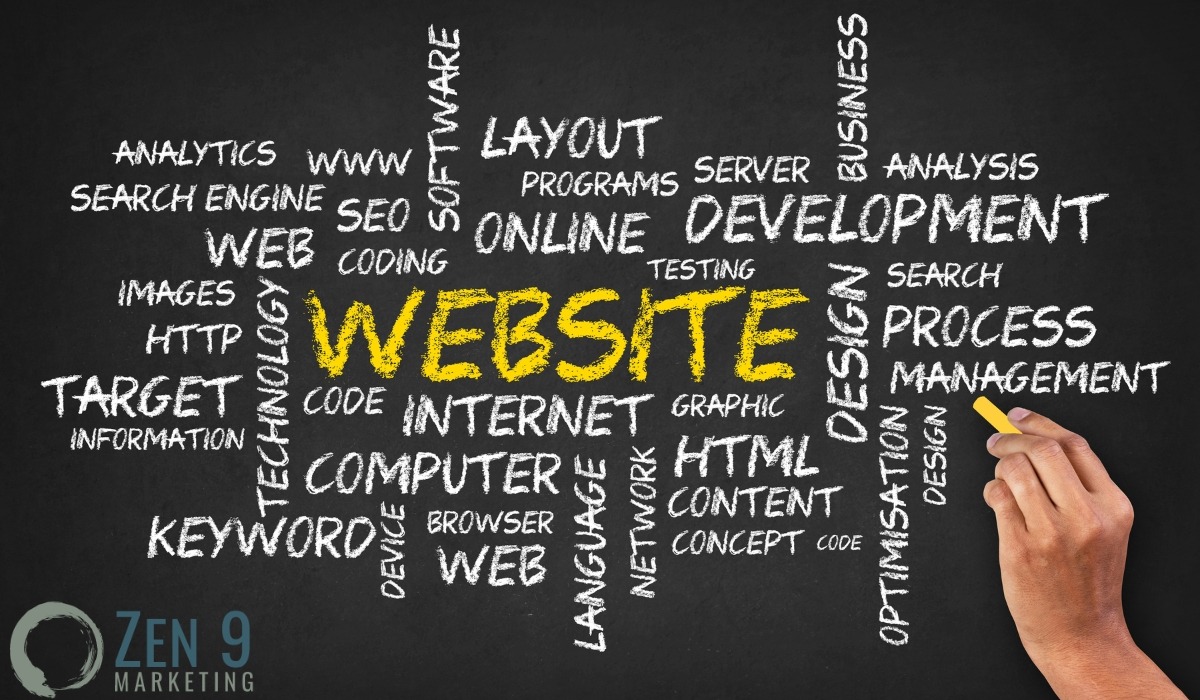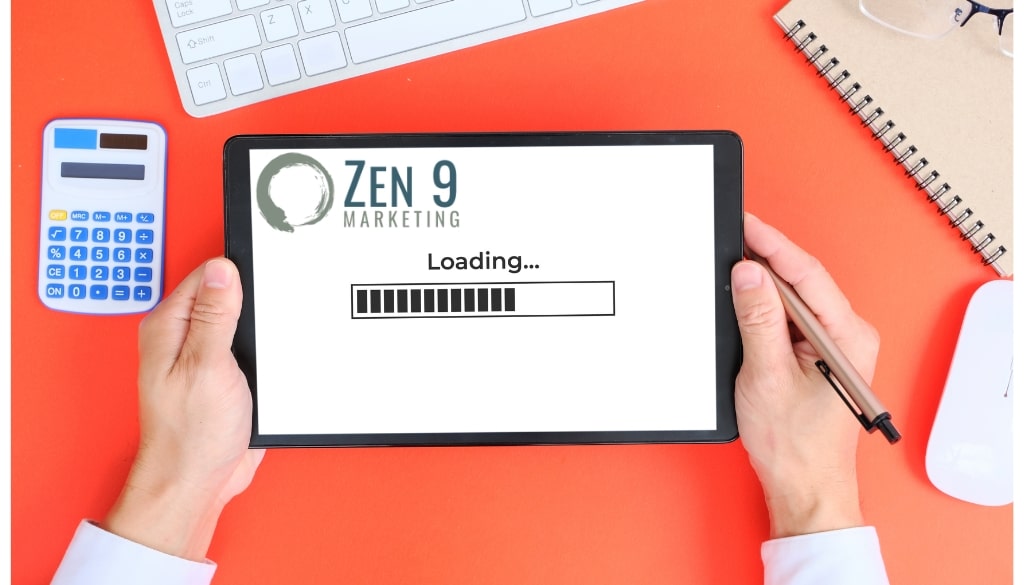In today’s digital world, making your website fast is key for small and medium-sized businesses (SMBs). A quick website can make a big difference in how customers interact with you. It affects both their experience and how well your site ranks on search engines.
Website speed is more than just a technical detail. It’s a big advantage for your business. People want websites that load fast, and search engines give higher rankings to those that do. A good website speed strategy can change how people see your brand.
At Zen 9 Marketing, we know how every second matters for businesses today. Google found that if a page takes more than one second to load, bounce rates jump by 123%. This means people might leave your site before they even see what you offer. This can hurt your sales big time.
Key Takeaways
- Website speed directly influences user engagement and conversion rates
- One-second delay can reduce conversions by 7%
- Fast-loading sites have lower bounce rates
- Search engines prioritize quick-loading websites
- Mobile optimization is crucial for modern businesses
Understanding Page Speed and Its Impact on Business Success
Website performance is key for small and medium-sized businesses. As the digital world gets more crowded, it’s vital to focus on improving website loading time for SMBs.
Page speed is how fast a website loads. It includes several important metrics that affect user experience and site performance. Google suggests a load time under 2 seconds for the best results, which can greatly impact user engagement and business success.
What Defines Page Speed
Several key components define page speed:
- Time to First Byte (TTFB)
- First Contentful Paint (FCP)
- Total Page Load Time
- Interactive Page Readiness
The Business Cost of Slow Websites
Slow websites can cost a lot. Even giants like Amazon see big losses from small delays. Our studies show websites taking over 3 seconds to load might lose up to 40% of visitors.
Speed’s Impact on User Behavior
In today’s fast-paced digital world, users have little patience. Slow websites lead to higher bounce rates and less engagement. Mobile users are especially impatient, with average load times hitting 27.3 seconds.
By focusing on website speed, SMBs can offer better digital experiences. This leads to more conversions and supports business growth over time.
The Direct Connection Between Site Speed and Conversion Rates
Speed is a silent killer of online conversions. For small businesses, knowing how site speed affects customer engagement is key. Studies show that website loading speed greatly impacts conversion rates.
Here are some stats that show speed’s power:
- A one-second delay can cut conversion rates by up to 17%
- 53% of mobile users leave sites that take over three seconds to load
- About 70% of shoppers say page speed affects their buying decisions
Real examples show the financial benefits of speed optimization. The NCC Group cut page load time by 850 milliseconds and saw a 7% conversion jump. Walmart saw a 2% conversion increase for every second of faster load times.
| Load Time | Conversion Impact |
|---|---|
| 1 second | Optimal conversion potential |
| 3 seconds | 50% potential conversion loss |
| 5 seconds | 90% increased bounce probability |
For small businesses, choosing fast website hosting is a smart move. It leads to better user experiences, lower bounce rates, and more sales.
Core Web Vitals: Google’s Speed Metrics That Matter
Small business websites face big challenges in meeting Google’s standards. Core Web Vitals for SMB Websites are key to success online. They check how fast a site loads, how interactive it is, and how stable it looks.

Google created these benchmarks to improve digital experiences. By knowing these metrics, small businesses can boost their search rankings and make users happier.
Breaking Down the Key Performance Indicators
Our website development strategies focus on three main Core Web Vitals metrics:
- Largest Contentful Paint (LCP)
- First Input Delay (FID)
- Cumulative Layout Shift (CLS)
Largest Contentful Paint (LCP)
LCP checks how fast a page’s main content loads. Aim for LCP to be under 2.5 seconds. This shows how fast a page seems to load to users.
| LCP Performance | Loading Time | User Experience Impact |
|---|---|---|
| Good | 0-2.5 seconds | Positive User Engagement |
| Needs Improvement | 2.5-4.0 seconds | Potential User Frustration |
| Poor | 4+ seconds | High Bounce Rates |
First Input Delay (FID)
FID looks at how fast a site responds to user actions. Aim for FID to be 200 milliseconds or less. This makes a site feel quick and interactive.
Cumulative Layout Shift (CLS)
CLS checks if a page’s layout stays stable while loading. Aim for a CLS score under 0.1. This means the page’s elements don’t move around too much, keeping users calm and avoiding mistakes.
How Slow Loading Times Affect SEO Rankings
Search engines like Google now see website speed as key to ranking. Over 25% of users leave if a site takes more than 3 seconds to load. This shows how big of a deal page speed is for SEO.
Google started using page speed as a ranking factor in 2010. And it’s gotten even more important. The 2021 introduction of Page Experience Signals made speed even more crucial for rankings.
- Mobile page speed is now a key ranking factor
- Faster websites have lower bounce rates
- Speed directly influences user engagement
Core Web Vitals are important for measuring website performance. These include:
| Metric | Impact on SEO |
|---|---|
| Largest Contentful Paint (LCP) | Measures loading performance |
| First Input Delay (FID) | Evaluates interactivity |
| Cumulative Layout Shift (CLS) | Assesses visual stability |
For small and medium businesses, making websites faster is not just a tech thing. It’s a key strategy for getting seen online. A one-second delay can cut conversions by 7%. So, speed is a big win for business.
By focusing on website speed, businesses can boost their search rankings. They can also make users happier and get more visitors to their sites.
Website Speed Optimization: Essential Techniques for SMBs
Small and medium-sized businesses face unique challenges when it comes to improve website loading time SMB performance. Our digital world needs websites that load fast to grab and keep user attention. Sites that load in just one second can see their conversion rates triple. So, making your website fast is not just a technical fix—it’s a key business strategy.

Let’s look at some practical ways to make your website faster without spending a lot.
Image Optimization Strategies
Images are often the main reason websites load slowly. Here are some key tips to help:
- Compress images using tools like TinyPNG
- Use modern WebP image formats
- Implement responsive image techniques
- Leverage lazy loading for better performance
Code Minification Methods
By making your website’s code more efficient, you can make it load faster. Here are some strategies:
- Remove unnecessary spaces and comments
- Combine multiple CSS and JavaScript files
- Use GZIP compression to reduce file sizes
- Leverage HTTP/2 for parallel file processing
Caching Implementation
Caching makes websites load faster for people who visit them again. By storing website elements locally, it reduces server load and boosts site performance for SMBs.
Remember, a website that loads in under three seconds can greatly improve user engagement and conversion rates. Our optimization methods are here to help small businesses succeed online.
Mobile Speed Optimization: A Priority for Modern Businesses
Mobile devices have changed how we use the internet. Now, most people access the web on their phones. This means businesses must focus on making their websites fast on mobile.
Fast mobile websites are crucial. Slow sites can lose customers. Here are some important tips for mobile speed:
- 63% of visitors bounce from pages taking over four seconds to load
- A one-second reduction can increase mobile conversions by 3%
- Mobile pages loading over 5 seconds risk losing potential customers
To improve mobile speed, focus on a few key areas:
- Responsive design that adapts seamlessly across devices
- Compressed and optimized images
- Minimized code and reduced server response times
- Efficient mobile-specific caching strategies
With 5G coming, users want websites to load even faster. Businesses need to make their sites quick to meet these expectations. Fast mobile sites make users happy, improve search rankings, and boost sales.
Tools and Methods to Measure Your Site’s Performance
For small and medium businesses, tracking website performance is key. Page Speed Test Tools give insights into how fast websites load. They work on different devices and networks.
Our guide covers the best tools for checking website speed and finding performance problems. These tools offer tips to make websites load faster and improve user experience.
Google PageSpeed Insights
Google’s Page Speed Test Tool is free and detailed. It uses Lighthouse 6.0 to check Core Web Vitals and gives tips. It has:
- Instant scores for mobile and desktop
- Details on loading times
- Specific ways to improve
GTmetrix and WebPageTest
GTmetrix and WebPageTest give deeper insights into performance. They offer:
- Waterfall charts for resource loading
- Grades for performance
- Comparisons of different page versions
Chrome DevTools
Chrome DevTools is a strong tool for developers and tech-savvy owners. It lets you watch network and performance in real-time in the browser.
Using these Page Speed Test Tools regularly helps businesses keep their site fast. This ensures a great user experience and can boost search rankings.
Common Speed Bottlenecks and How to Address Them
Web performance is tough for small and medium businesses. To speed up websites, we need to know the common slowdowns. Our study shows key areas where websites often face problems.
Key performance challenges include:
- Unoptimized images consuming excessive bandwidth
- Multiple unnecessary HTTP requests
- Render-blocking JavaScript code
- Inefficient server configurations
Fixing these issues begins with a detailed performance check. We suggest looking closely at each possible slowdown. For example, big images can slow down websites a lot. By compressing images, some sites see a 70% speed boost.
| Bottleneck Type | Performance Impact | Optimization Strategy |
|---|---|---|
| Image Overhead | 25-50% Slowdown | Compress, resize, use modern formats |
| HTTP Requests | 15-30% Load Time Increase | Minimize external scripts, leverage browser caching |
| Unoptimized Code | 20-40% Performance Drag | Minify CSS/JavaScript, eliminate redundant code |
Our team excels in website development that focuses on speed and user experience. By tackling these bottlenecks, businesses can greatly improve their online presence and user interaction.
Hosting Considerations for Optimal Website Performance
Choosing the right hosting is key for small businesses wanting fast websites. Your hosting’s performance affects user experience, search rankings, and business success.
Small businesses have big decisions to make when picking a host. The hosting environment greatly affects website speed and reliability. Our research shows that hosting choices are crucial for website performance.
Selecting the Right Hosting Provider
When looking for fast website hosting for small businesses, consider these factors:
- Server resources allocation
- Scalability options
- Performance guarantees
- Technical support quality
Different hosting types offer different performance levels:
| Hosting Type | Performance | Cost |
|---|---|---|
| Shared Hosting | Low | $3-$10/month |
| VPS Hosting | Medium | $20-$100/month |
| Dedicated Server | High | $100-$500/month |
CDN Implementation Benefits
A Content Delivery Network (CDN) can greatly improve website speed. By caching content across global servers, CDNs reduce latency and enhance user experience for businesses targeting international audiences.
Smart hosting investments can transform your website’s performance. This can lead to better user engagement and business growth.
The ROI of Investing in Website Speed Optimization
Small and medium-sized businesses (SMBs) are learning how vital website speed is. Investing in ways to make websites load faster is more than just a technical fix. It’s a smart business move that can bring in big financial gains.
Let’s look at some numbers that show why website speed matters:
- Slow websites can cost businesses up to $2.6 billion each year
- Just one second of delay can lead to a 7% drop in sales
- 40% of visitors leave if a website takes over 3 seconds to load
Real-life examples show how fast websites can change a business. A mid-sized online store saw huge improvements. They cut their load time from 6.2 to 2.8 seconds. This led to a big drop in bounce rates, from 72% to 39%.
The numbers don’t lie. Their monthly sales jumped from $50,000 to $85,000, a 70% increase in just six months.
But the benefits don’t stop there. Faster websites also get better SEO rankings, better user experience, and more loyal customers. Search engines favor websites that load quickly, making speed key to success online.
For SMBs wanting to grow online, investing in website speed is not a cost. It’s a chance to make more money.
Conclusion
Our journey shows that for small and medium-sized businesses, website speed is key. With 81% of marketers knowing speed boosts conversions, the future is clear. Website speed optimization is more than tech—it’s a business must.
Core Web Vitals for SMB websites are crucial. A one-second delay can drop customer satisfaction by 16% and conversion rates by 7%. Google found that slower pages lead to 123% higher bounce rates, making speed vital for success.
Walmart saw a 2% conversion rate jump per second of improvement. Mozilla’s downloads rose by 15.4%. The proof is clear: fast websites are a competitive edge. Invest in speed, focus on performance, and see your online presence grow.
The digital world changes fast, and speed is our best ally. By using the strategies we’ve discussed, keeping an eye on Core Web Vitals, and staying ahead, SMBs can make websites that are fast and effective. This turns visitors into loyal customers. If you need help getting your site up to snuff, contact Zen 9 Marketing today and learn how we can help!

